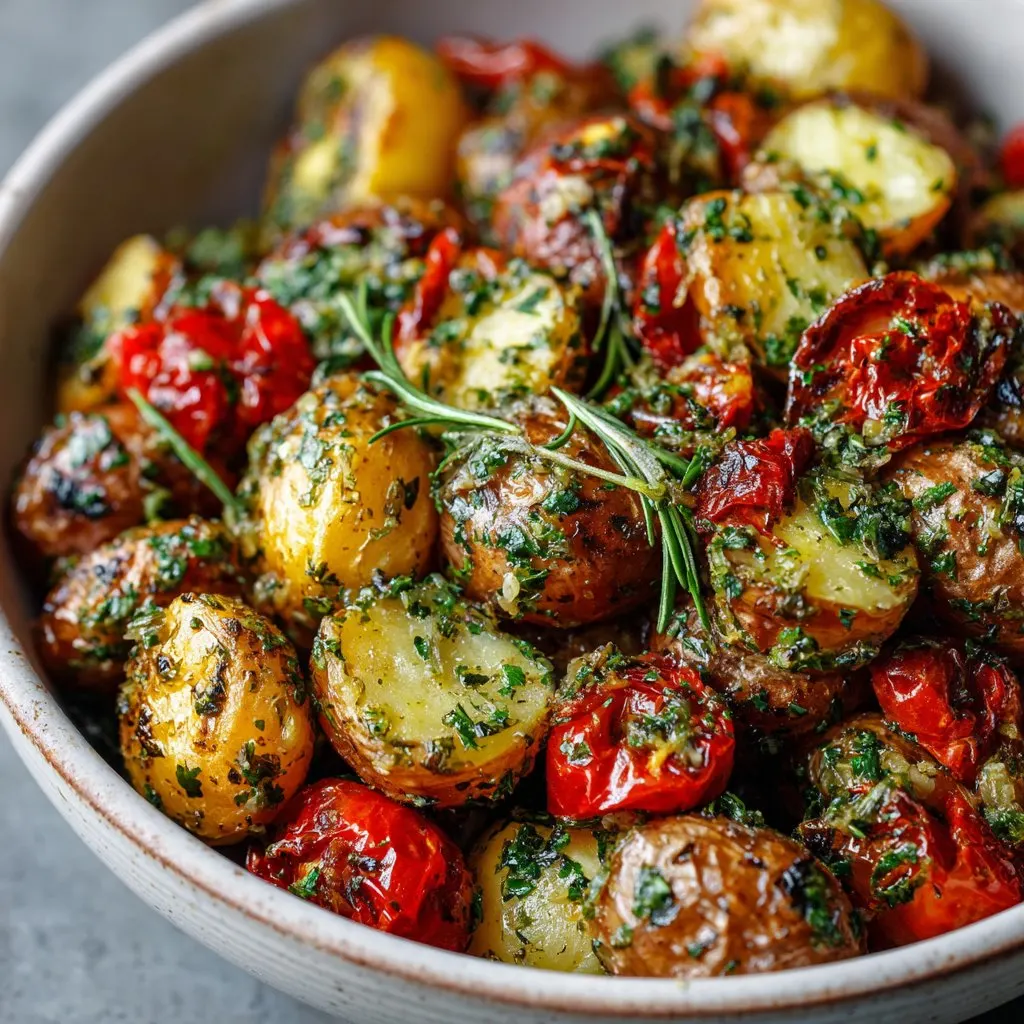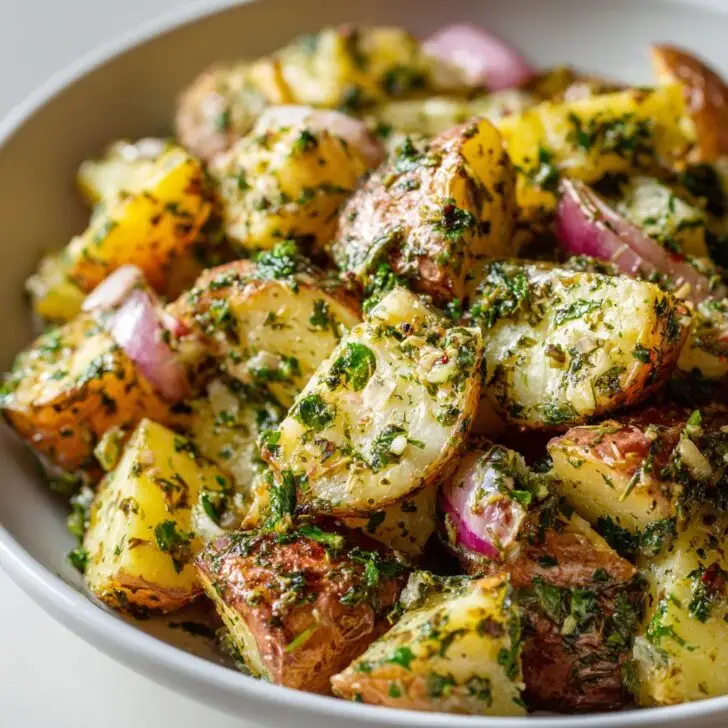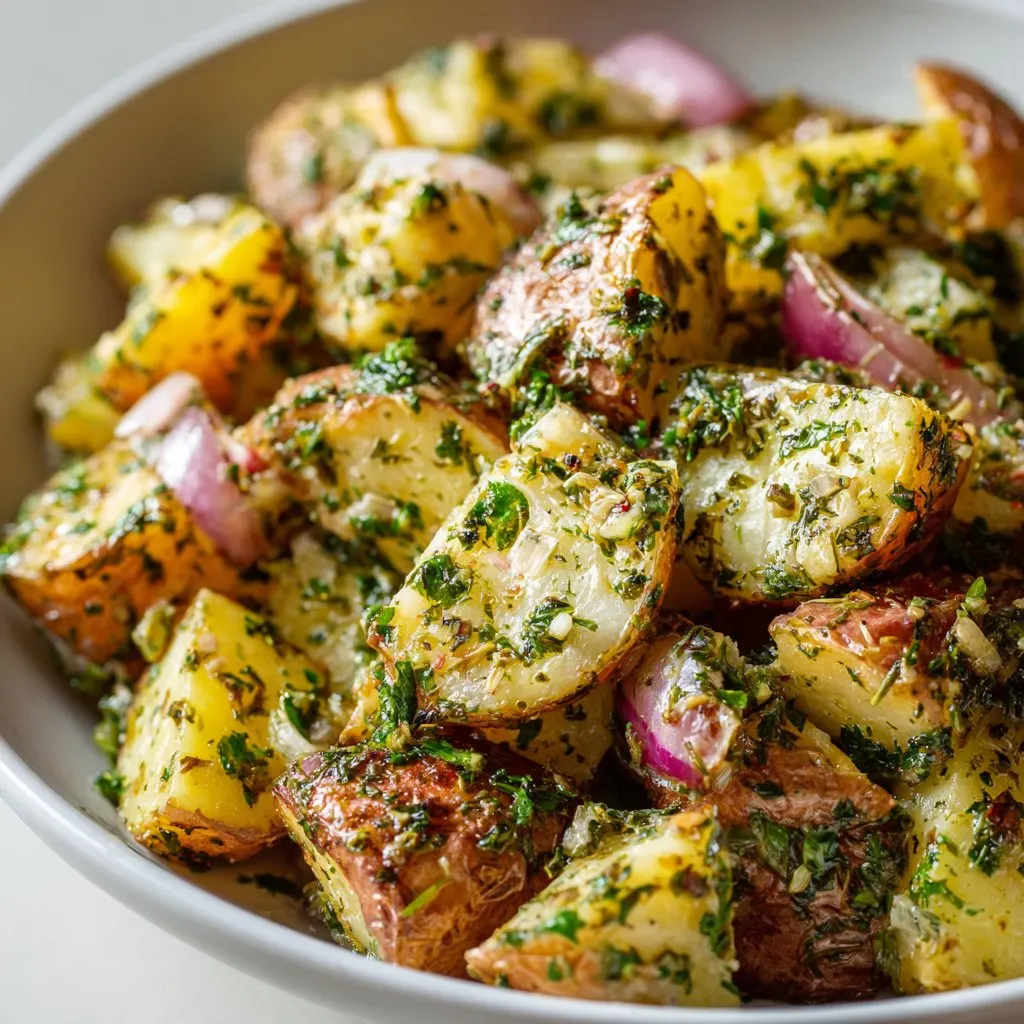Let Me Tell You About This Herbed Roasted Potato Salad
Okay, so this Herbed Roasted Potato Salad Recipe is one of those things I make when I want something that feels a bit fancy but actually—don’t tell anyone—it’s super chill to throw together. The first time I made this, I was running late for a picnic and honestly, I just didn’t want to boil potatoes and deal with mayo. Roasting them instead? Total game changer! My sister still teases me about the time I dropped half the tray (thankfully, the five-second rule applies if nobody's watching). Anyway, if you’re after a potato salad that’s not the same old mush, you’re in the right place.
Why I Keep Coming Back to This
I make this when I can't face another gloppy, mayo-heavy salad (you know the type). My family goes a bit wild for it because the potatoes get all crispy around the edges, and honestly, the herbs just do something magical. Even my cousin Paul, who usually picks out anything green, eats this without complaining. Also, let’s be real—sometimes I just want a dish I can eat straight from the mixing bowl while I’m standing in the kitchen. No judgement if you do the same.
Here’s What You’ll Need (Plus My Usual Substitutions)
- 1½ lbs baby potatoes (I sometimes use Yukon Golds, chunked; red potatoes are grand too)
- 2-3 tablespoon olive oil (I’ve used avocado oil when I ran out—didn’t hate it!)
- 1 teaspoon kosher salt (my gran always swore by Maldon, but any flakey salt will do)
- ½ teaspoon black pepper (freshly cracked if you’re feeling fancy, or just whatever’s in the grinder)
- 2 tablespoon fresh parsley, chopped (I sometimes go heavy-handed here, but dried works in a pinch; just use less)
- 1 tablespoon fresh dill, chopped (or chives if dill’s not your jam)
- 1 tablespoon fresh thyme leaves (honestly, I’ve skipped this before and nobody noticed)
- 1 garlic clove, minced (pre-minced stuff is fine if you’re in a rush)
- Zest of ½ lemon (or skip it—just adds a zing)
- 1-2 teaspoon Dijon mustard (optional; but I love the bite it gives)
- ½ small red onion, very thinly sliced (optional, but it looks nice)
How I Actually Make This (With All My Usual Mess-Ups)
- Preheat your oven to 425°F (220°C). Yes, it’s hot, but you want crispy, right?
- Chop the potatoes into bite-sized pieces. Or don’t—if they’re tiny enough, just halve them. (This is where I usually sneak a taste of raw potato. Don’t tell anyone.)
- Toss potatoes with olive oil, salt, pepper, and garlic on a baking sheet. Use your hands if you’re like me—just wash them after. Spread them out so they’re not all crowded (they need personal space).
- Roast for about 25–30 minutes, flipping once or twice. Don’t worry if some get a bit too brown—those are the best bits, actually.
- Let potatoes cool for a few minutes (unless you love burning your tongue, which—no judgment, but I’ve learned my lesson). Meanwhile, in a big bowl, mix herbs, lemon zest, mustard, and more olive oil if you want. This is a no-judgment zone.
- Add the warm potatoes and toss everything together. This is where I usually taste and inevitably add more salt. (And sometimes more lemon, depending on my mood, or if I got distracted and forgot it the first time.)
- Toss in the red onion if you’re using it. Or skip it and pretend you did. That’s genuinely it!
What I’ve Learned: Notes on This Dish
- Using fresh herbs makes a difference, but I’ve totally used dried in winter when my garden’s just mud.
- Letting the potatoes cool a bit helps the flavors settle. But I’ll admit—sometimes I eat half straight off the pan anyway.
- If you love a creamy vibe, a blob of Greek yogurt mixed in is actually not bad (my friend Sarah insists on this, and I have to admit she’s onto something).
Tinkering: Variations I’ve Actually Tried
- I once threw capers in for a salty punch—tasted great to me, but my nephew made a face.
- Swapped dill for basil once. Wasn’t my favorite, but if that’s what you’ve got, give it a whirl.
- Added a handful of crumbled feta for a party—people asked for the recipe, so it must have worked.
- One time I tried adding raisins (don't ask why)—that was not a win. You live and learn.
Tools I Use (and What to Do If You Don’t Have Them)
- Baking sheet—though I have used a big cast-iron skillet when my sheet was busy with cookies.
- Mixing bowl—any large bowl will do (I’ve mixed in a soup pot in a pinch, honestly).
- A decent knife for the herbs, but I’ve hacked at them with kitchen scissors too. Works fine.

Keeping It Fresh (Storage Tips From a Serial Leftover Eater)
This keeps in the fridge for 2–3 days. Actually, I think it tastes better the next day. Though, honestly, in my house it never lasts more than a day because someone always sneaks seconds (or thirds). If you want to reheat, it gets a tad mushy but still tasty—like potato magic soup, kind of.
How I Serve It (and What Goes With)
I love this with grilled chicken or just a fried egg slapped on top—breakfast, lunch, doesn’t matter. My cousin insists on serving it with sausages at her backyard parties. Oh, and sometimes I pile it on toast like a proper weirdo. Goes great with anything from a green salad to a slab of crusty bread.
Lessons Learned (Here’s What Not To Do)
- I once tried rushing the roasting and cranked the oven higher. Don’t. You’ll get burnt outsides and raw insides—ask me how I know.
- Don’t skip the resting time for the potatoes, even if you’re hungry. The flavors actually do settle in better if you wait a few minutes. (But I’m impatient sometimes, so, up to you!)
- If you overdress with oil, it’ll get greasy. I did that once and ended up blotting with paper towels. Not my finest moment.
FAQs I Actually Get From Friends (and Strangers at Potlucks)
- Can I make this ahead? Yep, I’ve made it a day before and it’s still fab—just give it a chance to come to room temp before serving, or the flavors hide a bit.
- Can I use dried herbs? You can, and I have. Use about a third as much as you would fresh, or it can get overpowering. Also, maybe skip the dried dill—it tastes odd to me.
- How do I make it vegan? It’s already vegan (unless you add cheese or yogurt), so you’re sorted.
- What potatoes are best? I love little waxy ones, but hey, use what you’ve got. Russets will work—they just get fluffier inside.
- Why are my potatoes soggy? Probably crowded the pan (been there). Spread ‘em out and use a hot oven. Or maybe you didn’t dry them enough after washing—lesson learned!
- Where do you get your herbs? In summer, straight form my garden (or the neighbor’s if mine look sad). Otherwise, the supermarket bundles are just fine.
For more ideas on herbs, Bon Appetit’s handy herb guide is genuinely helpful. And if you want to geek out on potato varieties, I once spent way too long on Love Food Hate Waste’s potato breakdown—worth a read, honestly.
So, there you go—my most foolproof, not-too-serious, herby potato salad. Make it yours (and let me know if you find a way to make raisins work—I’m not trying again, but you never know!).
Ingredients
- 2 pounds baby potatoes, halved
- 2 tablespoons olive oil
- 1 teaspoon salt
- ½ teaspoon black pepper
- ½ cup chopped fresh parsley
- 2 tablespoons chopped fresh dill
- ¼ cup finely chopped red onion
- ¼ cup mayonnaise
- 2 tablespoons Dijon mustard
- 1 tablespoon apple cider vinegar
Instructions
-
1Preheat the oven to 425°F (220°C). Line a baking sheet with parchment paper.
-
2In a large bowl, toss the halved baby potatoes with olive oil, salt, and black pepper until evenly coated.
-
3Spread the potatoes in a single layer on the prepared baking sheet. Roast for 25-30 minutes, turning once halfway, until golden and tender. Let cool slightly.
-
4In a large mixing bowl, whisk together mayonnaise, Dijon mustard, apple cider vinegar, parsley, dill, and red onion.
-
5Add the roasted potatoes to the bowl and gently toss to coat with the herbed dressing. Serve warm or at room temperature.
Approximate Information for One Serving
Nutrition Disclaimers
Number of total servings shown is approximate. Actual number of servings will depend on your preferred portion sizes.
Nutritional values shown are general guidelines and reflect information for 1 serving using the ingredients listed, not including any optional ingredients. Actual macros may vary slightly depending on specific brands and types of ingredients used.
To determine the weight of one serving, prepare the recipe as instructed. Weigh the finished recipe, then divide the weight of the finished recipe (not including the weight of the container the food is in) by the desired number of servings. Result will be the weight of one serving.
Did you make this recipe?
Please consider Pinning it!!


